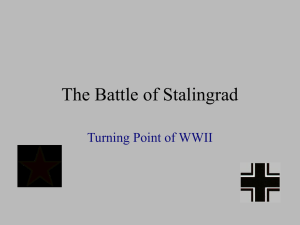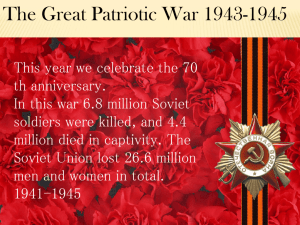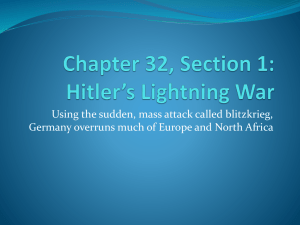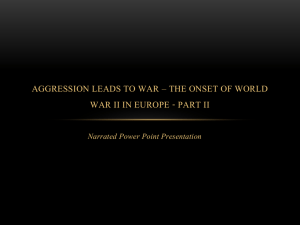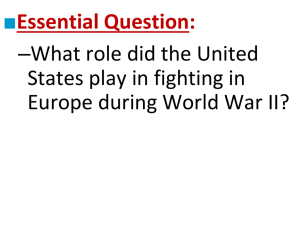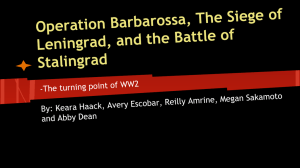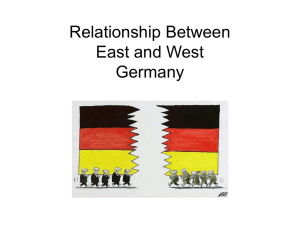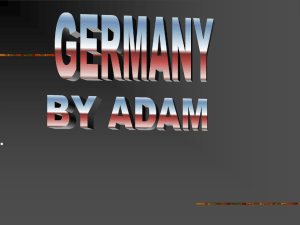Rattenkrieg
advertisement
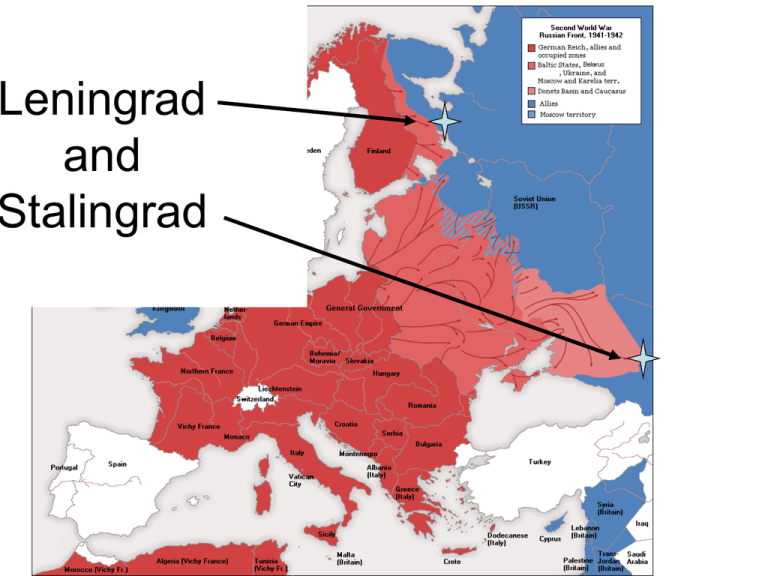
Leningrad and Stalingrad Significance? • Blitzkrieg failed to deliver the knockout blow to Russia • Thus Germany would have to fight through the winter • The German army laid siege to Leningrad and Stalingrad, hoping to starve the civilians into surrender or annihilation Problem? • “The German army is like an elephant attacking a host of ants. He will crush and kill thousands, perhaps millions; but in the end, their numbers will overcome him, and he will be eaten in the end. “ – - German Soldier Stalin's order 227 Translated to english by our friend Frank. ----------------------------------------------------------The Order of the National Commissar for the Defense of the Soviet Union. July 28 1942, Moscow. The enemy throws new forces to the front without regard to heavy losses and penetrates deep into the Soviet Union, seizing new regions, destroying our cities and villages, and violating, plundering and killing the Soviet population. Combat goes on in region Voronej, near Don, in the south, and at the gates of the Northern Caucasus. The German invaders penetrate toward Stalingrad, to Volga and want at any cost to trap Kuban and the Northern Caucasus, with their oil and grain. The enemy already has captured Vorochilovgrad, Starobelsk, Rossosh, Kupyansk, Valuyki, Novochercassk, Rostov on Don, half Voronej. Part of the troops of the Southern front, following the panicmongers, have left Rostov and Novochercassk without severe resistance and without orders from Moscow, covering their banners with shame. The population of our country, who love and respect the Red Army, start to be discouraged in her, and lose faith in the Red Army, and many curse the Red Army for leaving our people under the yoke of the German oppressors, and itself running east. Some stupid people at the front calm themselves with talk that we can retreat further to the east, as we have a lot of territory, a lot of ground, a lot of population and that there will always be much bread for us. They want to justify the infamous behavior at the front. But such talk is falsehood, helpful only to our enemies. Each commander, Red Army soldier and political commissar should understand that our means are not limitless. The territory of the Soviet state is not a desert, but people - workers, peasants, intelligentsia, our fathers, mothers, wives, brothers, children. The territory of the USSR which the enemy has captured and aims to capture is bread and other products for the army, metal and fuel for industry, factories, plants supplying the army with arms and ammunition, railroads. After the loss of Ukraine, Byelorussia, Baltic republics, Donetzk, and other areas we have much less territory, much less people, bread, metal, plants and factories. • We have lost more than 70 million people, more than 800 million pounds of bread annually and more than 10 million tons of metal annually. Now we do not have predominance over the Germans in human reserves, in reserves of bread. To retreat further - means to waste ourselves and to waste at the same time our Motherland. Therefore it is necessary to eliminate talk that we have the capability endlessly to retreat, that we have a lot of territory, that our country is great and rich, that there is a large population, and that bread always will be abundant. Such talk is false and parasitic, it weakens us and benefits the enemy, if we do not stop retreating we will be without bread, without fuel, without metal, without raw material, without factories and plants, without railroads. This leads to the conclusion, it is time to finish retreating. Not one step back! Such should now be our main slogan.It is necessary to defend each position, each meter of our territory, up to the last drop of blood, tocling for each plot of Soviet land and to defend it as long as possible. Our Motherland is experiencing hard days.We must stop, and then to throw back and smash the enemy regardless of cost. The Germans are not so strong, as it seems to the panic-mongers. Leningrad • Old capital of Russia • Home of the Russian Revolution (when known as St. Petersburg) • Base of the Soviet Baltic fleet • For three years, all land routes into the city were blocked • Civilians had not been evacuated • One route in and out- the ‘Road of Life’ across Lake Ladoga (continued) • The two-and-a-half year siege caused the greatest destruction and the largest loss of life ever known in a modern city • On Hitler's express orders, most of the palaces of the Tsars, and other historic landmarks located outside the city's defensive perimeter were looted and then destroyed • The siege of Leningrad is the most lethal siege in world history • The 872 days of the siege caused unparalleled famine in the Leningrad region through disruption of utilities, water, energy and food supplies. This resulted in the deaths of up to 1,500,000 soldiers and civilians • In the winter of 1941-42, rations were down to 50 grams of bread per person, per day – 1 gram = 1 paper clip of weight – 60% of this ‘bread’ was made of sawdust • Starving, the people of Leningrad resorted to eating leather briefcases, the paste behind wallpaper, and cannibalism World at War Red Star Clip • 11 minutes – 24 minutes (poem) 1942- Stalingrad- THE Battle • Valued by Hitler as a propaganda piece (personal test of wills) and a key piece in taking the oil and wheat in the Caucasus • Stalin issued Order 227 and refused to allow civilians out in order to make the soldiers fight harder • 80% of the city was destroyed by the Luftwaffe • Bloodiest battle in history (2 million total casualties) • Street by street fighting – At one point, the Germans owned 90% of the city • Broke the back of the Nazis… turning point in the war “The Soviets understood that, in Stalingrad, the best defense would depend on anchoring their defense lines in numerous buildings overseeing strategically important streets and squares. Such a strategy would hold for as long as possible all the ground the Soviets could take in the city. Thus, they converted multi-floored apartment blocks, factories, warehouses, street corner residences and office buildings into strongholds bristling with machine guns, antitank rifles, mortars, mines, barbed wire, snipers and small 5 to 10 man units of submachine gunners and grenadiers prepared for house-to-house combat. Bitter fighting raged for every ruin, street, factory, house, basement and staircase. The sewers were the sites of labyrinthine firefights. The Germans, calling this unseen urban warfare Rattenkrieg ("Rat War"), bitterly joked about capturing the kitchen but still fighting for the living room.” Strain of the Battle • German commander developed an uncontrollable eye tic • Soviet commander developed a skin rash so bad that he had to bandage his hands entirely • Some Soviet munitions factories built tanks while fighting raged in the building… • For periods of the battle, the average life expectancy of a Soviet soldier arriving in the city was less than 24 hours Some have argued that the Germans lost more men trying to take this house than taking Paris Soviet counterattack… •Battle lasted for about 6 months •Germans surrounded •Hitler orders them to be resupplied by air •3000 tons a day dropped to an army that needs 5000 •Starvation •German General Paulus begs Hitler to allow a break out… told to stand and fight •Hitler promotes Paulus to field marshal and tells him ‘No German field marshal has ever been captured alive’ •Paulus and his 91k men surrender… less than 6 k ever see Germany again… 22 German generals captured Post Stalingrad- Germans Always on the Retreat from Soviet Armies Hansen Name ______________ The Battles of Leningrad and Stalingrad World War II • Significance? – Blitzkrieg failed to __________________________ – Thus Germany would have to fight _________________ – The German army laid ___________ to Leningrad and Stalingrad, hoping to ___________________________ __________________ or annihilation • Problem? – “The German army is like an _________ attacking ___ _______ _________________. He will crush and kill thousands, perhaps millions; but in the end, _________ _______________________, and he will be eaten in the end. “ German Soldier • What is the central point of Stalin’s Order 227? _____________________________ __________________________________ • Leningrad – Old _________ of Russia – Home of the _______________________________ (when known as St. Petersburg) – Base of the Soviet _____________________ – For three years, all ____routes into the city were blocked – Civilians had not ______________________ – One route in and out- the ________________________ ____________________________________________ – – – – – – • The two-and-a-half year siege caused the greatest destruction and the largest loss of life _____________________________ On Hitler's express orders, most of the __________________ ____________________________________ located outside the city's defensive perimeter were looted and then destroyed The siege of Leningrad is the most lethal siege in __________ The 872 days of the siege caused unparalleled famine in the Leningrad region through disruption of utilities, water, energy and food supplies. This resulted in the deaths of up to _________________ soldiers and civilians In the winter of 1941-42, rations were down to _____________ __________________________________________________ • 1 gram = 1 ___________________ of weight • 60% of this ‘bread’ was made of _______________ Starving, the people of Leningrad resorted to _____________ _________________________________________________ World at War Clip- What happened to the tears of the people in Leningrad, according to the film? ______________________ __________________ Explain! ________________________ __________________________________________________ • • • • • 1942- Stalingrad- ______________ – Valued by Hitler as a propaganda piece (_____________ _______________ ) and a key piece in taking the oil and wheat in the _______________ – Stalin issued Order 227 and refused to allow civilians out in order ___________________________________ – 80% of the city was destroyed by ___________________ – ________________________ (2 million total casualties) – Street by street fighting – At one point, the Germans owned ___________________ Broke the back of the Nazis… ___________________________ – Strain of the Battle – German commander developed an _________________ – Soviet commander developed a ___________ so bad that he had ________________________________________ – Some Soviet munitions factories built tanks while ______ ______________________________________________ – For periods of the battle, the average life expectancy of a Soviet soldier arriving in the city ____________________ Battle lasted for about _____________________ – Germans _________________ – Hitler orders them to _______________________ – 3000 tons a day dropped to an army that needs ________ – Starvation – German General Paulus begs Hitler to allow a break out… ____________________________________ – Hitler promotes Paulus to field marshal and tells him ______________________________________________ ________ . Meaning? ____________________________ – Paulus and his 91k men ________… less ________ ever see Germany again… 22 German _________________ Post Stalingrad- Germans ___________________ from Soviet Armies Enemy at the Gates Film Clip – – – What is interesting about the way guns are handed out to the Soviet soldiers? ___________________________________ _____________________________________________ What happens when the Soviet forces retreat at the end of the clip? ________________________________________________
